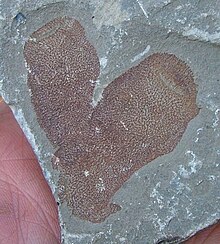| Hazeliidae Temporal range: | |
|---|---|
 | |
| A specimen of Hazelia at the Mount Stephen Trilobite Beds | |
| Scientific classification | |
| Domain: | Eukaryota |
| Kingdom: | Animalia |
| Phylum: | Porifera |
| Class: | Demospongiae |
| Order: | † Protomonaxonida |
| Family: | † Hazeliidae Walcott, 1920 |
| Genera | |
| |
Hazeliidae is an extinct family of spicular Cambrian sea sponges known from the Burgess Shale, the Marjum Formation of Utah, [3] and possibly Chengjiang. [1] It was described by Charles Walcott in 1920.